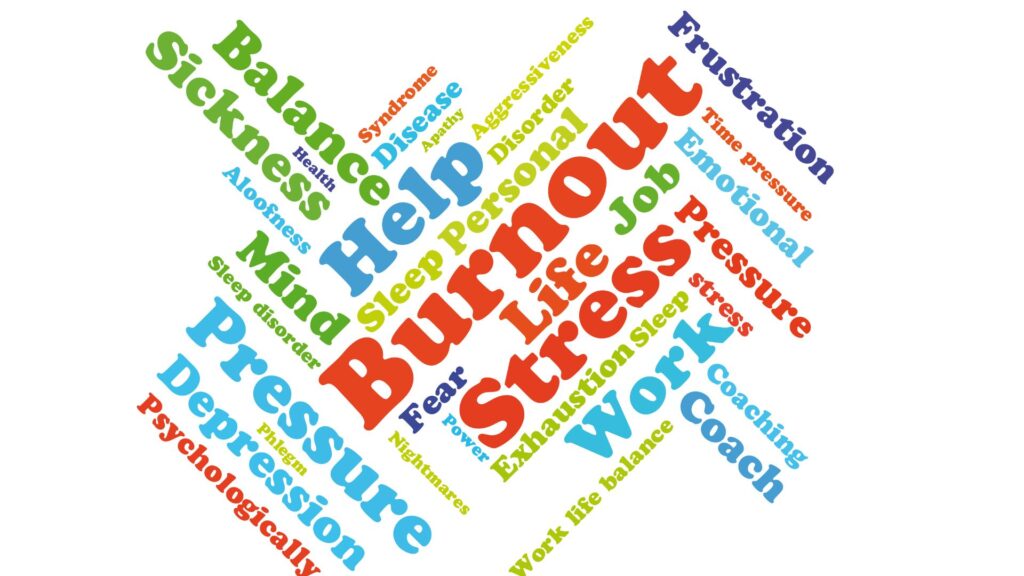What is burnout?
Burnout, increasingly a focal point in the modern workforce and mental health discussions, manifests as a state of emotional, physical, and mental exhaustion caused by prolonged stress. It occurs when you feel overwhelmed, emotionally drained, and unable to meet constant demands. As the stress continues, you begin to lose the interest and motivation that led you to take on a certain role in the first place. Burnout reduces productivity and saps your energy, leaving you feeling increasingly helpless, hopeless, cynical, and resentful. Eventually, you may feel like you have nothing more to give.
The impact of burnout can be wide-ranging, touching every aspect of an individual’s life. It not only affects work performance but also, health, personal relationships, and overall happiness. With the rapid changes in workplace dynamics, especially with the shift towards remote work in response to global challenges, understanding burnout has never been more critical. It’s essential to recognize that anyone can reach a point of burnout, regardless of their job role or career stage. It’s not limited to those in high-stress jobs or positions of leadership; it can affect anyone from teachers and medical professionals to office workers and stay-at-home parents.
The onset of burnout is often subtle, with signs and symptoms developing slowly over time. It can start with the feeling of being physically and emotionally drained, the dread of what the workday might hold, or the sense of being undervalued and underappreciated. However, as it progresses, the symptoms become more severe and may include chronic fatigue, insomnia, physical symptoms such as headaches and stomachaches, and increased susceptibility to illnesses due to a weakened immune system.
Moreover, the psychological effects of burnout are profound. Sufferers may experience detachment from their job and colleagues, a decrease in performance, a sense of failure or self-doubt, and a looming sense of defeat. These symptoms, in turn, can lead to depression, anxiety, and other serious mental health issues. Consequently, understanding, preventing, and addressing burnout is not merely a personal responsibility but a collective one, requiring awareness and intervention at both the individual and organizational levels.
The reasons behind burnout are multifaceted. Work-related causes include excessive workload, lack of control over one’s work, insufficient rewards for effort, lack of a supportive community, lack of fairness, and mismatched values and job demands. Personal factors such as personality traits (e.g., perfectionism), lifestyle (e.g., lack of work-life balance), and social support systems also play a significant role. The complexity of these contributing factors means that solutions must be equally multifaceted, addressing both the environmental and personal aspects of burnout.
As the conversation around mental health continues to evolve, the stigma surrounding burnout is slowly diminishing, allowing for more open discussions on prevention strategies and support mechanisms. This evolving understanding is crucial in developing effective interventions to mitigate the effects of burnout and support those affected in their recovery journey. By addressing the root causes of burnout and implementing comprehensive support systems, we can create healthier work environments and a more resilient workforce, ultimately fostering a more balanced and fulfilling life for individuals across the spectrum of employment.
In the following sections of this article, we will delve deeper into the signs and symptoms of burnout, explore its causes, and discuss strategies for prevention and recovery. Through personal stories and expert insights, we aim to provide a comprehensive overview of burnout, offering guidance and support to those who may be experiencing it and advice on how to avoid it in the future.

Signs and symptoms of burnou
Burnout is a state of physical, emotional, and mental exhaustion that can have far-reaching consequences on an individual’s well-being and overall quality of life. The signs and symptoms of burnout can manifest in various ways, and it’s crucial to recognize them early to prevent further deterioration.
Physical signs
Persistent fatigue and energy depletion
One of the most prominent signs of burnout is persistent fatigue and a lack of energy. Affected individuals may feel drained and experience overwhelming exhaustion even when performing routine tasks. Additionally, burnout can disrupt sleep patterns, leading to insomnia or excessive sleeping, further exacerbating the physical symptoms.
Emotional disturbances
Diminished motivation and engagement
Emotionally, burnout can manifest as a lack of motivation and engagement. Those experiencing burnout may become increasingly negative, cynical, or apathetic towards their work or personal life. They may struggle to find joy or satisfaction in activities that once brought them fulfillment, and their relationships may suffer as a result of their emotional detachment.
Apathy and emotional numbness
Burnout can also lead to a sense of apathy and emotional numbness, where individuals may feel disconnected from their own emotions or the emotions of others. This emotional dullness can further strain relationships and lead to a lack of empathy or compassion.
Cognitive impairments
Concentration and decision-making difficulties
Mentally, burnout can impair cognitive function, leading to difficulties in concentrating, decision-making, and problem-solving. Individuals may experience a noticeable decline in their performance or productivity, as their ability to focus and think clearly becomes compromised. This mental strain can also contribute to feelings of inadequacy, self-doubt, and a sense of failure, further exacerbating the emotional toll.
Beyond these core symptoms, burnout can also manifest in various physical and behavioral changes, such as changes in appetite, weight fluctuations, substance abuse, or other addictive behaviors. Recognizing the signs and symptoms of burnout is the first step in addressing the issue and seeking appropriate support and lifestyle changes to regain a sense of balance and well-being.
Causes of burnout: Uncovering the underlying factors
While the signs and symptoms of burnout are often recognizable, understanding the root causes is crucial for effective prevention and intervention. Burnout can arise from a complex interplay of various factors, including workplace dynamics, personal traits, and broader societal influences.

Workplace factors contributing to burnout
Work overload and lack of control
One of the primary contributors to burnout in the workplace is work overload, where employees feel overwhelmed by excessive demands, unrealistic deadlines, and a lack of control over their workload. When individuals feel they have little autonomy or influence over their job responsibilities, it can lead to a sense of powerlessness and increased stress levels.
Lack of recognition and reward
Burnout can also stem from a perceived lack of recognition and reward for one’s efforts. When employees feel their hard work goes unnoticed or underappreciated, it can foster feelings of resentment and a diminished sense of self-worth, ultimately leading to burnout.
Workplace conflicts and toxic environments
Unhealthy workplace dynamics, such as interpersonal conflicts, bullying, or toxic leadership styles, can contribute significantly to burnout. Constant tension, hostility, and lack of support from colleagues or superiors can erode an individual’s emotional well-being and lead to chronic stress.
Personal factors increasing burnout risk
Perfectionism and unrealistic expectations
Individuals with perfectionistic tendencies may be more susceptible to burnout, as they often set unrealistic expectations for themselves and struggle to maintain a sustainable work-life balance. Perfectionism can lead to overcommitting, workaholism, and an inability to delegate or ask for help, ultimately resulting in emotional and physical exhaustion.
Difficulty managing stress and emotions
Some individuals may have a harder time coping with stress and managing their emotions effectively. Poor stress management skills, coupled with a tendency to ruminate or dwell on negative experiences, can exacerbate burnout symptoms and make it more challenging to recover.
Personal life stressors and lack of support
Burnout can also be influenced by external factors outside the workplace, such as personal life stressors, relationship difficulties, or a lack of a supportive social network. When individuals lack a healthy work-life balance or are unable to detach from work-related stress, it can compound the effects of burnout.

Societal and cultural influences on burnout
Always-on culture and digital overload
The modern always-on culture, fueled by constant connectivity and digital overload, can contribute to burnout. The blurring of boundaries between work and personal life, coupled with the expectation of immediate responsiveness, can create a sense of constant pressure and leave individuals feeling overwhelmed.
Work-life imbalance and prioritization of work
In many societies, there is a prevailing cultural emphasis on work, often at the expense of personal and family life. This imbalance, where work is prioritized over leisure, self-care, and relationships, can lead to burnout as individuals struggle to maintain a healthy equilibrium.
Stigma surrounding mental health and self-Care
Unfortunately, there is still a stigma surrounding mental health issues and the importance of self-care in many cultures. This stigma can prevent individuals from seeking help or implementing necessary lifestyle changes to address burnout, perpetuating a cycle of exhaustion and diminished well-being.
Addressing burnout requires a multifaceted approach that acknowledges and addresses these various contributing factors. By fostering a healthy work environment, promoting self-care and stress management, and challenging societal norms that contribute to burnout, individuals and organizations can work together to create a more sustainable and fulfilling work-life experience.
The far-reaching impact of burnout: Effects on individuals and their environment
While burnout is often viewed as an individual experience, its consequences can extend far beyond the person suffering from its effects. The ripple effects of burnout can profoundly impact an individual’s physical and mental health, personal relationships, and professional life, ultimately affecting their entire environment.
Detrimental effects on physical and mental well-being
Psychosomatic illnesses and Weakened immune system
Burnout can take a significant toll on an individual’s physical health, increasing the risk of various psychosomatic illnesses. Chronic stress and emotional exhaustion can weaken the immune system, making individuals more susceptible to infections, colds, and other illnesses. Additionally, burnout has been linked to a higher incidence of conditions such as headaches, gastrointestinal issues, and cardiovascular problems.
Anxiety, Depression, and Emotional instability
The mental health consequences of burnout can be equally severe. Individuals experiencing burnout are at a higher risk of developing anxiety and depression, as the constant stress and feelings of inadequacy can lead to a negative thought pattern and emotional instability. This can further exacerbate burnout symptoms, creating a vicious cycle that is difficult to break without proper intervention and support.
Sleep disturbances and fatigue
One of the most common symptoms of burnout is persistent fatigue and sleep disturbances. Individuals may struggle with insomnia, restless sleep, or excessive sleeping, all of which can contribute to a lack of energy, decreased concentration, and an overall diminished quality of life.
Strained personal relationships and isolation
Family tensions and conflicts
Burnout can have a significant impact on an individual’s personal relationships, particularly within the family unit. The emotional exhaustion and irritability that often accompany burnout can lead to increased tensions, conflicts, and a lack of patience with loved ones. This can create an atmosphere of stress and strain within the home environment, further exacerbating the individual’s sense of burnout.
Deterioration of friendships and social connections
As burnout progresses, individuals may find themselves withdrawing from social connections and friendships. The emotional detachment and lack of energy can make it challenging to maintain relationships, leading to a sense of isolation and a lack of support from their social network.
Difficulty maintaining work-life balance
Burnout can make it extremely difficult for individuals to maintain a healthy work-life balance. The constant demands and pressure can blur the boundaries between work and personal life, resulting in a neglect of leisure activities, hobbies, and self-care practices that are essential for overall well-being.
Workplace productivity and performance implications
Decreased productivity and efficiency
One of the most significant impacts of burnout in the workplace is a noticeable decline in productivity and efficiency. Individuals experiencing burnout may struggle to concentrate, make decisions, and complete tasks in a timely manner, ultimately affecting their overall job performance.
Increased absenteeism and turnover
Burnout can also lead to higher rates of absenteeism, as individuals may take more sick days or personal time off to cope with their physical and emotional exhaustion. In severe cases, burnout can contribute to increased employee turnover, as individuals may decide to leave their jobs in search of a more sustainable work environment.
Workplace errors and safety concerns
When individuals are suffering from burnout, their cognitive function and attention to detail can be compromised, increasing the risk of workplace errors, accidents, and potential safety concerns. This can have serious implications not only for the individual but also for their colleagues, customers, or clients, depending on the nature of their work.
Addressing burnout requires a comprehensive approach that involves both individual and organizational efforts. By promoting self-care practices, implementing supportive policies, and fostering a healthy work culture, individuals and organizations can work together to mitigate the negative impacts of burnout and create a more sustainable and fulfilling work-life experience for all.

Addressing burnout: strategies for prevention and recovery
While burnout can have far-reaching consequences, there are proactive measures individuals and organizations can take to prevent its onset and effectively manage its impact. By implementing a multi-faceted approach that combines self-care strategies, professional support, and workplace interventions, it is possible to mitigate the risks of burnout and promote a healthier, more sustainable work-life balance.
Self-help strategies for burnout management
Stress management techniques
Developing effective stress management techniques is crucial for combating burnout. Practices such as mindfulness meditation, deep breathing exercises, and progressive muscle relaxation can help individuals cultivate greater emotional resilience and reduce the physical and psychological effects of stress.
Time management and prioritization
Burnout often stems from an overwhelming workload and a lack of control over one’s time. Learning effective time management strategies, such as setting realistic goals, prioritizing tasks, and practicing the art of saying “no,” can help individuals regain a sense of control and prevent feelings of being overwhelmed.
Engaging in hobbies and leisure activities
Pursuing hobbies and leisure activities outside of work can provide a much-needed respite from burnout. Engaging in activities that bring joy, relaxation, and a sense of accomplishment can help individuals detach from work-related stress and recharge their mental and emotional batteries.
Seeking Professional Support
Counseling and therapy
In some cases, burnout may require professional intervention from a licensed therapist or counselor. Cognitive-behavioral therapy (CBT) and other evidence-based approaches can help individuals identify and address the underlying thought patterns and behaviors contributing to their burnout, as well as develop coping strategies for managing stress and improving overall well-being.
Life coaching and career counseling
For those struggling with burnout related to their career or work-life balance, seeking guidance from a life coach or career counselor can be beneficial. These professionals can provide personalized advice and strategies for aligning one’s career goals with their values and priorities, ultimately promoting greater job satisfaction and fulfillment.
Employee Assistance Programs (EAP’s)
Many organizations offer Employee Assistance Programs (EAPs) as part of their employee benefits package. These programs provide confidential counseling, resources, and support services to help employees manage various personal and work-related challenges, including burnout.
Workplace interventions and organizational strategies
Improving work conditions and policies
Employers and organizations play a critical role in preventing and addressing burnout among their workforce. Implementing policies that promote work-life balance, such as flexible schedules, remote work options, and generous paid time off, can help alleviate some of the common contributors to burnout.
Workload evaluation and redistribution
Regularly evaluating and redistributing workloads can prevent employees from becoming overwhelmed and overburdened. Ensuring that tasks and responsibilities are equitably distributed and that resources are available to support employees can significantly reduce the risk of burnout.
Fostering a supportive organizational culture
Creating a supportive and inclusive organizational culture is essential for addressing burnout. Encouraging open communication, promoting mental health awareness, and providing opportunities for team building and social support can cultivate a sense of belonging and camaraderie among employees.
Overcoming burnout requires a collaborative effort between individuals, employers, and society as a whole. By prioritizing self-care, seeking professional support when needed, and implementing workplace interventions that promote a healthy work-life balance, individuals and organizations can foster a more sustainable and fulfilling work environment, ultimately benefiting not only the individual but also the broader community.

Remote work and the new challenges of burnout
The COVID-19 pandemic has reshaped the way we work, with remote work becoming a necessity for many organizations. While remote work offers several benefits, such as increased flexibility and reduced commuting time, it also presents new challenges when it comes to burnout prevention and management. As we navigate this new landscape, it’s essential to understand the unique aspects of remote work and develop strategies to mitigate the risks of burnout.
The double-edged sword of remote work
Advantages of remote work for burnout prevention
Remote work can potentially alleviate some of the traditional contributors to burnout. Eliminating daily commutes can reduce stress and fatigue, while the flexibility of remote work can allow for better work-life integration. Additionally, the ability to create a personalized workspace can contribute to a sense of comfort and control, which can be beneficial for overall well-being.
Challenges of remote work and burnout risk
However, remote work also introduces new challenges that can increase the risk of burnout. The blurred boundaries between work and personal life can lead to longer working hours, difficulty disconnecting, and a constant state of availability. Social isolation and lack of in-person interactions can contribute to feelings of loneliness and disconnect, potentially exacerbating burnout symptoms.
The role of self-regulation in remote work
Maintaining structure and routine
One of the keys to successful remote work and burnout prevention is self-regulation. Without the physical separation of an office environment, it becomes crucial to establish a structured routine and dedicated workspace. Setting clear boundaries between work and personal time can help maintain a healthy work-life balance and prevent burnout.
Combating distractions and procrastination
Remote work also requires a heightened level of self-discipline and focus. With the abundance of distractions at home, it’s essential to develop strategies for staying on task and avoiding procrastination. Time management techniques, such as the Pomodoro method or time-blocking, can help increase productivity and prevent burnout caused by constant task-switching and multitasking.
Tips for effective remote work and burnout prevention
Establishing clear communication and collaboration channels
Effective communication and collaboration are vital for remote teams to thrive. Utilizing video conferencing tools, project management software, and instant messaging platforms can help foster a sense of connection and ensure seamless collaboration, reducing the risk of burnout caused by misunderstandings or lack of support.
Prioritizing self-care and work-life balance
In a remote work environment, it’s easy to neglect self-care and personal well-being. Establishing routines for physical activity, mindfulness practices, and hobbies outside of work can help counterbalance the potential stressors of remote work and prevent burnout.
Seeking support and fostering remote team bonding
While remote work can lead to feelings of isolation, it’s essential to seek support from colleagues, managers, and mental health professionals when needed. Organizations can foster remote team bonding through virtual team-building activities, social events, and open discussions about mental health and well-being.
As the world of work continues to evolve, addressing the unique challenges of remote work and burnout prevention will become increasingly important. By embracing self-regulation, establishing clear boundaries, and prioritizing self-care and support, individuals and organizations can navigate the remote work landscape while mitigating the risks of burnout and promoting overall well-being.

Burnout and society: A widespread concern
Burnout is not merely an individual issue; it has far-reaching implications for society as a whole. As the nature of work continues to evolve, the prevalence of burnout has become a growing concern, with significant social and economic costs. Addressing burnout requires a collective effort from individuals, organizations, and policymakers to create a more sustainable and healthy work culture.
The changing landscape of work and it’s impact on burnout
The rise of the gig economy and precarious employment
The rise of the gig economy and the proliferation of precarious employment arrangements, such as temporary contracts and freelance work, have contributed to increased stress and uncertainty for workers. The lack of job security, inconsistent income, and limited access to benefits can exacerbate burnout symptoms and make it challenging for individuals to maintain a healthy work-life balance.
The pressure of constant connectivity and digital overload
The ubiquity of digital technologies and the expectation of constant connectivity have blurred the boundaries between work and personal life. The relentless stream of emails, notifications, and virtual meetings can create a sense of perpetual urgency, contributing to burnout and making it difficult for individuals to disengage from work-related stress.
The demands of the knowledge economy and cognitive overload
The modern knowledge economy places high cognitive demands on workers, requiring them to process vast amounts of information, multitask, and rapidly adapt to changing technologies and market conditions. This cognitive overload can lead to mental fatigue, decreased productivity, and an increased risk of burnout, particularly in high-pressure industries such as technology, finance, and healthcare.
The societal and economic costs of burnout
Impact on productivity and organizational performance
Burnout can have far-reaching consequences for organizational performance and productivity. Employees experiencing burnout are more likely to call in sick, make mistakes, and exhibit decreased engagement and creativity, ultimately impacting the bottom line. Additionally, high turnover rates due to burnout can be costly for organizations, as they must invest in recruiting and training new employees.
Strain on healthcare systems and public resources
The physical and mental health consequences of burnout can place a significant strain on healthcare systems and public resources. Individuals suffering from burnout-related conditions may require medical treatment, counseling, or other support services, contributing to increased healthcare costs and resource utilization.
Societal implications and Quality of Life
Beyond the economic impacts, burnout can also have broader societal implications. Individuals experiencing burnout may struggle to maintain healthy personal relationships, contribute to their communities, and engage in civic activities, ultimately affecting the overall quality of life for themselves and those around them.
The importance of burnout prevention for workplace well-being
Promoting mental health awareness and destigmatization
Addressing burnout requires a cultural shift towards greater mental health awareness and the destigmatization of mental health issues in the workplace. By creating an open and supportive environment where employees feel comfortable discussing burnout and seeking help, organizations can take proactive steps to prevent and mitigate its impact.
Implementing workplace policies and practices for work-life balance
Organizations can play a critical role in burnout prevention by implementing policies and practices that promote work-life balance and employee well-being. This may include flexible work arrangements, generous leave policies, and initiatives that encourage physical activity, mindfulness, and stress management.
Fostering a supportive and inclusive organizational culture
Creating a supportive and inclusive organizational culture is essential for addressing burnout. By encouraging open communication, promoting diversity and inclusion, and providing opportunities for professional development and growth, organizations can cultivate a sense of purpose, belonging, and job satisfaction among employees, reducing the risk of burnout.
Burnout is a complex issue that requires a multifaceted approach involving individuals, organizations, and society as a whole. By acknowledging the societal costs of burnout and prioritizing workplace well-being, we can create a more sustainable and fulfilling work environment, ultimately benefiting individuals, organizations, and the broader community.

Personal stories and lessons learned: Overcoming burnout
While burnout can be a daunting and overwhelming experience, there are countless individuals who have successfully navigated through this challenge and emerged stronger and more resilient on the other side. Their personal stories and lessons learned offer valuable insights and inspiration for those currently grappling with burnout or seeking preventive strategies.
Case studies: Triumphing over burnout
Sarah’s story: Rediscovering passion and purpose
Sarah, a high-powered executive in the tech industry, found herself on the brink of burnout after years of relentless work and neglecting self-care. She struggled with chronic fatigue, anxiety, and a loss of motivation. However, after seeking professional help and implementing a comprehensive self-care plan, Sarah was able to rediscover her passion for her work and regain a sense of purpose. Today, she advocates for work-life balance and serves as a mentor for other professionals facing burnout.
Michael’s journey: Embracing mindfulness and resilience
Michael, a healthcare professional, experienced burnout due to the high-stress nature of his job and the emotional toll of caring for patients. He found himself increasingly detached from his work and personal life. Through mindfulness practices, such as meditation and yoga, Michael learned to cultivate emotional resilience and better manage stress. He also sought support from colleagues and implemented boundaries to protect his personal time, ultimately regaining a sense of fulfillment in his career.
Emma’s transformation: Finding strength in community
Emma, a teacher, was on the verge of leaving her profession due to burnout caused by overwhelming workloads and lack of support. However, she found solace and strength in connecting with a community of fellow educators who were facing similar challenges. Together, they advocated for better working conditions, shared coping strategies, and supported one another through difficult times. Emma’s story highlights the power of collective action and the importance of seeking support from others who understand the unique challenges of a profession.
Lessons and advice from burnout survivors
Prioritize self-care and set boundaries
One of the most common pieces of advice from those who have overcome burnout is the importance of prioritizing self-care and setting boundaries. This may involve establishing a consistent routine for exercise, hobbies, and relaxation, as well as learning to say “no” to additional commitments that could compromise work-life balance.
Seek professional help and support systems
Many burnout survivors emphasize the value of seeking professional help, whether through counseling, therapy, or coaching. Additionally, building a supportive network of family, friends, and colleagues can provide a crucial source of encouragement and understanding during the recovery process.
Reframe perspective and embrace resilience
Overcoming burnout often requires a shift in perspective and a cultivation of resilience. Burnout survivors encourage individuals to reframe their mindset, focusing on personal growth, gratitude, and finding meaning in their work and life experiences. Embracing a resilient mindset can help individuals better navigate challenges and bounce back from setbacks.
By sharing their personal stories and lessons learned, burnout survivors offer hope and guidance to those facing similar struggles. Their experiences serve as a reminder that burnout is a surmountable challenge and that with the right tools, support, and mindset, it is possible to regain a sense of balance, fulfillment, and well-being.

Conclusion: Embracing a holistic approach to burnout
As we delve deeper into the complexities of burnout, it becomes evident that this phenomenon is multifaceted and influenced by a myriad of factors. From individual traits and workplace dynamics to societal and cultural norms, burnout is a pervasive issue that requires a comprehensive understanding and a collaborative effort to address effectively.
The multifactorial nature of burnout
A convergence of personal, professional, and societal factors
Burnout arises from the intricate interplay of personal factors, such as personality traits, coping mechanisms, and life circumstances, with professional factors like workload, job demands, and organizational culture. Furthermore, broader societal influences, including cultural expectations, technological advancements, and economic shifts, can exacerbate or alleviate the risk of burnout.
The ripple effect of burnout
The impact of burnout extends far beyond the individual experiencing it. It can have profound consequences on personal relationships, workplace productivity, and organizational success. Moreover, burnout can have a ripple effect on society, affecting healthcare systems, economic productivity, and overall quality of life.
The importance of prevention and proactive strategies
Fostering resilience and self-care practices
Preventing burnout begins with cultivating resilience and adopting self-care practices. Individuals can take proactive steps to manage stress, set boundaries, and prioritize their physical and mental well-being through techniques such as mindfulness, exercise, and hobbies.
Promoting supportive workplace cultures and policies
Organizations play a crucial role in preventing burnout by fostering supportive workplace cultures and implementing policies that promote work-life balance, employee well-being, and mental health awareness. This can include initiatives such as flexible work arrangements, employee assistance programs, and training on stress management and burnout prevention.
Addressing societal attitudes and norms
On a broader scale, addressing burnout requires challenging societal attitudes and norms that contribute to unhealthy work-life imbalances and stigmatize mental health issues. This involves raising awareness, promoting open discussions, and advocating for policies and initiatives that support overall well-being.
A call to action: Collaboration and social responsibility
Overcoming the challenges posed by burnout demands a collaborative effort from individuals, organizations, and society as a whole. It requires a shared responsibility and a commitment to creating a more sustainable and fulfilling work-life experience for all.
By embracing a holistic approach that recognizes the multifaceted nature of burnout, we can develop comprehensive strategies that address its root causes and mitigate its far-reaching impacts. Through personal self-care, organizational support, and societal awareness, we can pave the way for a future where burnout is no longer a silent epidemic but a challenge that is proactively addressed and overcome.
“Seeking help for burnout isn’t a sign of weakness; it’s the bravest step towards reclaiming your energy, purpose, and joy.”
